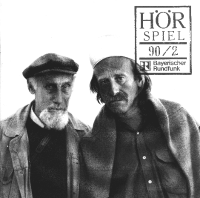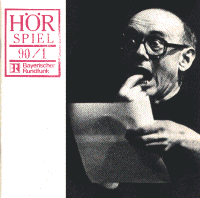Hörspiel
 The Hörspiel or
'listen-play' has had a long history in Germany, even though radio plays first
originated in America in 1922 with 'The Wolf.' The German radio networks came
into existence in 1924 and works in hörspiel started appearing in
1925. Many German writers at the time like Alfred Döblin, Walter Benjamin,
and Bertolt Brecht wrote extensive articles comparing the potential effect
radio would have on spoken language to that of what the Gutenberg revolution
did for written language [1].
The Hörspiel or
'listen-play' has had a long history in Germany, even though radio plays first
originated in America in 1922 with 'The Wolf.' The German radio networks came
into existence in 1924 and works in hörspiel started appearing in
1925. Many German writers at the time like Alfred Döblin, Walter Benjamin,
and Bertolt Brecht wrote extensive articles comparing the potential effect
radio would have on spoken language to that of what the Gutenberg revolution
did for written language [1].
Between 1933 to 1945 however, hörspiel
production was shut down with all its directors fired and replaced with members
of the Nazi propaganda machines. In 1945, the reconstruction of the German
radio network began. Most of the printing presses had been destroyed during the
war along with the ability to mass produce paper, and radios were more
pervasively available. The hörspiel therefore, became an acceptable
literary form among German writers: there was more of a chance of having a
piece played on the radio than to be published. The period between 1947 and
1960 is known as the Classic Period for hörspiel, and it is marked
by works about alienation, fear, isolation, and loss of identity within the
culture of post-war Germany. Inner reality and the subconscious were of great
interest by a people trying to rebuild their lives from the wreckage of their
past.
 By 1960 interest in the
hörspiel was waning largely however, due to a new economic
stability and the stagnating effects which television and mass media had the
serious artform. German radio, particularly Westdeutschen Rundfunk in Cologne,
began to allow more experimental German writers access to their recording
studios to produce hörspiel. This new work was marked by language
itself becoming the substance of the artform. Particularly there was an
introduction of 'quoted' prerecorded audio material in the form of slogans from
consumer advertisements, political propaganda, and the jargon of daily speech.
Much like the text-sound composition whose development occurred nearly
simultaneously, das neu hörspiel was an artform that
functioned aesthetically totally within the acoustical domain
[2]. The activity in Cologne and other regional
German broadcasters such as Bavarian Radio, in presenting a wide variety of new
and experimental works has continued to this day.
By 1960 interest in the
hörspiel was waning largely however, due to a new economic
stability and the stagnating effects which television and mass media had the
serious artform. German radio, particularly Westdeutschen Rundfunk in Cologne,
began to allow more experimental German writers access to their recording
studios to produce hörspiel. This new work was marked by language
itself becoming the substance of the artform. Particularly there was an
introduction of 'quoted' prerecorded audio material in the form of slogans from
consumer advertisements, political propaganda, and the jargon of daily speech.
Much like the text-sound composition whose development occurred nearly
simultaneously, das neu hörspiel was an artform that
functioned aesthetically totally within the acoustical domain
[2]. The activity in Cologne and other regional
German broadcasters such as Bavarian Radio, in presenting a wide variety of new
and experimental works has continued to this day.
References and Notes:
1. An anthology of historical and contemporary essays on
the potentials and impact of radio on Western culture can be found in
'Radiotext(e),' in Semiotext(e) #16, Vol. VI, Issue 1 (New York:
Semiotext(e), 1993).
2. A particularly detailed history in English about
Hörspiel can be found in the essay 'Sound Play: The Polyphonous
Tradition of German Radio Art,' by Mark E. Cory in Wireless Imagination:
Sound, Radio, and the Avant-Garde, edited by Douglas Kahn and Gregory
Whitehead (Cambridge, MA: The MIT Press, 1992). This book also contains other
essays concerning the artistic use of radio.
Another publication devoted to the study of the use of radio by artists,
can be found in Radio Rethink: Art, Sound and Transmission, edited by
Daina Augaitis and Dan Lander (Banff, Canada: Walter Phillips Gallery, 1994).
A World Wide Web page for
New American Radio
also exists.

Last Modified 20 January 1998
 The Hörspiel or
'listen-play' has had a long history in Germany, even though radio plays first
originated in America in 1922 with 'The Wolf.' The German radio networks came
into existence in 1924 and works in hörspiel started appearing in
1925. Many German writers at the time like Alfred Döblin, Walter Benjamin,
and Bertolt Brecht wrote extensive articles comparing the potential effect
radio would have on spoken language to that of what the Gutenberg revolution
did for written language [1].
The Hörspiel or
'listen-play' has had a long history in Germany, even though radio plays first
originated in America in 1922 with 'The Wolf.' The German radio networks came
into existence in 1924 and works in hörspiel started appearing in
1925. Many German writers at the time like Alfred Döblin, Walter Benjamin,
and Bertolt Brecht wrote extensive articles comparing the potential effect
radio would have on spoken language to that of what the Gutenberg revolution
did for written language [1].  By 1960 interest in the
hörspiel was waning largely however, due to a new economic
stability and the stagnating effects which television and mass media had the
serious artform. German radio, particularly Westdeutschen Rundfunk in Cologne,
began to allow more experimental German writers access to their recording
studios to produce hörspiel. This new work was marked by language
itself becoming the substance of the artform. Particularly there was an
introduction of 'quoted' prerecorded audio material in the form of slogans from
consumer advertisements, political propaganda, and the jargon of daily speech.
Much like the text-sound composition whose development occurred nearly
simultaneously, das neu hörspiel was an artform that
functioned aesthetically totally within the acoustical domain
By 1960 interest in the
hörspiel was waning largely however, due to a new economic
stability and the stagnating effects which television and mass media had the
serious artform. German radio, particularly Westdeutschen Rundfunk in Cologne,
began to allow more experimental German writers access to their recording
studios to produce hörspiel. This new work was marked by language
itself becoming the substance of the artform. Particularly there was an
introduction of 'quoted' prerecorded audio material in the form of slogans from
consumer advertisements, political propaganda, and the jargon of daily speech.
Much like the text-sound composition whose development occurred nearly
simultaneously, das neu hörspiel was an artform that
functioned aesthetically totally within the acoustical domain